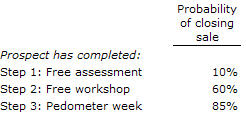Here’s a better way to manage your health and wellness sales pipeline, and align sales performance and compensation accordingly.
First, understand that only four outcomes are possible in a conversation with a prospective client or member:
- Sale – your prospect commits to buy now
- Milestone – your prospect takes specific action to move the sales process closer to a decision
- Continuation – your prospect’s interesting in continuing the conversation, but not ready to take a specific action
- No sale – your prospect actively refuses to make a commitment to buy
Here’s how to judge where your prospect is in the process –and how to align your sales team performance and compensation accordingly:
1) Actions speak louder than words.
Focus on what your prospects do, not just what they say. Look at their actions, and not just their words.
Why? Because most prospects will SAY positive, encouraging, even complimentary, things about your company, product or service without any interest whatsoever in actually buying something.
That’s why only their actions count.
2) Only milestones represent progress towards a decision.
You’ll improve your sales effectiveness by understanding the difference between an milestone and a continuation.
Continuations continue the sales process without moving your prospect closer to a decision.
- “Awesome presentation — you’ve really got a fantastic employee wellness program! Let’s meet again in a couple of months.”
- “We really liked the family membership you talked to us about and we’ll be in touch with any additional questions.”
- “This diabetes management program sounds great — I’ll definitely tell my boss about it.”
- “I’ll stop by for a tour of the fitness center soon.”
- “Your nutrition program sounds really good. I’ll see what my wife says.”
- Or other vaguely promising but noncommital responses
Salespeople often describe these interactions as very positive, very encouraging — “I think they’re really impressed with us.” Unfortunately, that doesn’t necessarily translate into sales.
Milestones, on the other hand, are actions by your potential customer that move them closer to a decision:
- “Let’s set up a pilot wellness coaching program next month with one department.”
- “I’d like you to meet my boss.”
- “I’d like to schedule a tour of the aquatics center.”
- “My wife would like to talk to the program director.”
- Or other proactive and specific steps like enrolling for a fitness assessment, a free seminar on vegetarian cooking or requesting a white paper on gamification and disease management.
Notice that the only actions that really count are those taken by a customer — not those taken unilaterally by salespeople. Handing someone an unasked-for brochure doesn’t count as a milestone. Giving a customer a packet of sales information doesn’t count as a milestone.
3) Plan your sales activities around milestones.
Plan every sales call — whether over the phone or in person — to achieve a specific action by the prospective customer. Which action is appropriate will depend upon the specific customer and where you are in their decision-making process.
Rather than trying to close the sale during the first discussion, a better approach is to identify key activities — short of an outright sale — that allow the prospect to edge closer and closer to a buying decision.
For example, you might ask them to sign up for a free newsletter, invite them plus a spouse or partner to a complimentary healthy living seminar, provide a complimentary health assessment or give them a free login to a site where they can track their daily activity.
Or, in a business-to-business setting, you could ask them to pilot your service or make an introduction to a key executive or other influencer, for example.
You can then propose one of these actions each time you connect with a particular prospect. This approach gives you a graceful way to maintain contact with a prospect and continue a process of “creeping commitment”– without prematurely trying to close the sale.
4) Recognize continuations for the non-progress they represent.
It’s easy to feel good about a continuation…until you realize that nothing much actually happened!
The best way to avoid this outcome is to target your sales activities towards a specific milestone (whatever’s appropriate and appealing for your prospect). We listed a few examples of milestones in #3, above.
It’s not enough to talk about a focus on milestones. Make sure that your salespeople have skin in the game by tying their compensation to these key customer actions.
5) Tie sales compensation to milestones, not just sales.
A compensation plan tied strictly to closed sales only makes sense if your salespeople have total control over the prospective customer’s decision. Of course, this is never the case in the real world. Salespeople can do a great job — but if the prospect’s not ready to buy, they’re not ready to buy and even the world’s greatest sales rep can’t change that.
Should you therefore shoot your salespeople because they didn’t “make their numbers”?
No. In fact, basing their compensation strictly on closed sales is a sure way to produce counterproductive behavior that ticks off potential customers, increases churn among the customers who do buy under these circumstances and actually harms your business and its bottom line in a multitude of measurable ways.
Instead, split their compensation among key milestones AND the actual sale.
Here’s a simplified example:
Say you’ve noticed that potential customers who
- agree to a complimentary lifestyle assessment,
- attend a free healthy living workshop and
- wear a pedometer for a week
are very likely to decide to buy your services. You also notice that prospective customers who don’t go through all three steps in order are much less likely to buy your services.
In that case, build a sales process that has four steps: get the prospect to sign up for the assessment….then get her to attend the workshop…and then get her to wear the pedometer. The final step would be to close the sale.
So you’d hypothetically pay 25% of the sales compensation when the prospect completed the assessment, another 25% for the workshop attendance, another 25% for the pedometer experience, and the final 25% if and when the sale finally closes.
That way you’re motivating your salespeople to follow the process that’s most likely to result in an actual sale. You reward them for actual progress towards a decision as prospects achieve milestones that you know move them closer.
6) Tired of unreliable and ridiculous sales forecasts?
Don’t ask your salespeople to tell you their estimate of how likely they are to close deals. They have no idea. That’s not because they’re bad salespeople, either. It’s because they don’t control the prospect’s behavior.
Instead, tie your sales forecasts to objective actions taken by the potential customer: their milestone achievements. Using our hypothetical example above, you could assign the following probabilities:
In other words, you’ve got a 60% chance of closing the sale with a prospect who’s done the assessment AND the workshop. But if all they’ve done is the free assessment, the likelihood of closing a deal is only 10%.
Obviously, the example is purely illustrative. Tailor the milestones and probabilities to the experience in your own business. And continually tweak and update as you refine your sales strategy.





